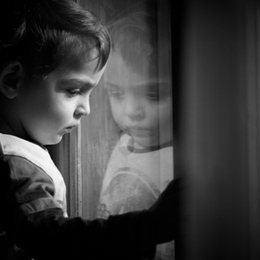
It wasn’t drug abuse that set the Dominguez family—pregnant Angela, 28; Jose, 23: and their two sons, both under age 3—on the path toward homelessness. It wasn’t alcoholism or mental health issues, domestic violence or natural disaster. They’re not high school dropouts, (on the contrary, Angela has a bachelor’s degree and New Jersey primary school teaching certification), and they’re not gamblers.
Rather, it was the things that can happen to anyone. Jose’s work, in the construction industry, dried up with the recession. A roommate failed to contribute his share of the rent. Angela’s income teaching private school just wasn’t enough to keep them afloat. They fell behind on the rent, and, last June, they were evicted.
“I felt like I failed as a father and as a husband,” Jose says. “It was rough. It had a big effect on me, as well as the kids and my wife. Being that she was pregnant with my daughter, it had a big impact on us—because it was like, ‘What are we going to do now? How are we supposed to take care of [our daughter] now?’”
It’s hard to say exactly how many people are homeless at any given time in Burlington, Camden and Gloucester counties. That’s because they’re scattered: in shelters or motels, crashing on friends’ couches, sleeping in their cars or camping in the woods behind suburban strip malls. However, the Corporation for Supportive Housing, which is tasked by New Jersey with analyzing the homeless count based on point-in-time statistics gathered on a single day each January, estimates that 3,653 people are homeless in our counties at some point during the year. They come not just from urban neighborhoods, but also from our most affluent communities.
“We get people from towns that are experiencing a lot of distress right now, like Pemberton and Mount Holly, but we do get calls from Marlton, Mount Laurel and even Medford. And last year we got calls from places like Mansfield and Chesterfield—and I was amazed, because those were not places I would have ever expected to get a call,” says Pat Lasusky, director of Interfaith Hospitality Network (IHN) of Burlington County, which took in the Dominguez family.
The group, driven by hundreds of volunteers from church groups across the county, provides homeless families with temporary housing on rollaway cots at host churches, which rotate from week to week. Guests spend the day at their jobs, at school or looking for work and housing at IHN’s Mount Laurel day center, and return at night to dinners prepared by volunteers from the local parishes.
Among IHN guests, the Dominguez family is all too typical, Lasusky says. The majority of guests are families with young children, especially single mothers whose meager income streams are fatally disrupted by maternity leave. “They fall behind, they can’t catch up, and they wind up being evicted,” she says. As was true in the Dominguezes’ case, relatives—themselves living in subsidized housing with strict rules against long-term guests—are unable to offer much help, if any at all.
So, the Dominguezes spent four months shuffling from one church to the next. “It wasn’t home or anything, but it wasn’t us living on the streets, which was a blessing, especially with me being pregnant and having the two boys,” Angela says. “Going from church to church was a little discouraging sometimes, but we kept our hope and got through it.”
Although the family was safe, their transitory existence took a toll in other ways. Their oldest son, who was nearly toilet-trained when the family was evicted, has “regressed. I still can’t get him potty trained,” Angela says. “At nighttime, he still needs his [pacifier] and his blanket. It’s not like it had a traumatic effect on him, but he still did know that he wasn’t home.”
Yet, the support did give Jose time to find a job, as a server at Applebee’s. And, because IHN allowed them to outstay the customary 60-day limit, it also enabled them to save enough for the first month’s rent and deposit on a two-bedroom apartment in Mount Holly. That was vital because, while Jose doesn’t make much, his paycheck is enough to exclude his family from receiving Temporary Assistance for Needy Families payments.
And Angela says she can’t get back to work because she won’t qualify for subsidized childcare until she gets a job; she can’t find a job without that childcare in place.
In the meantime, she worries that, with just one income stream, they could fall behind on the rent. “The worry is always in the back of my head—God forbid I don’t get a job,” she says. “But my husband always says he’ll never let that happen again.”
The Hidden Homeless
IHN of Burlington County can take about 25 families per year. Family Promise of Gloucester County, a sister organization, can only host four families or 14 people at a given time. That leaves more than 3,000 of our region’s homeless, who find themselves in broadly varied living situations.
While it may not be obvious to the rest of us, that does include those living outdoors, in the woods or on the streets.
This reality crystallizes when temperatures drop low enough to trigger a Code Blue, bringing homeless people to emergency shelters across the region. “We can hold up to 14 people a night, and this year we’ve been full almost every single night. We have had to turn people away,” says Salli Gordon, coordinator of the Triple Towns Ministerium Code Blue shelter in Riverside. “We open at 7 at night and we’re full by quarter after 7.”
Some of the guests do sleep outdoors when Code Blue shelter is unavailable. And, while Gordon tries to offer referrals to social service agencies, many return outdoors after the shelter closes. “Some days when it’s snowing really hard and we close at 7 a.m. and they have to go out into the snow, it’s tough,” Gordon says.
Moreover, an untold number of people are technically homeless, but are staying out of shelters by doubling up with friends or relatives.
That’s often the case among parents with schoolchildren, local administrators say. A federal law, the McKinney-Vento Homeless Assistance Act, enables students who become homeless to continue their educations at their home school districts, at the district’s expense. Washington Township, for one, currently has about 35 homeless children attending school under McKinney-Vento, according to school district spokesperson and homeless liaison Jan Giel.
Others, given the stigma attached to homelessness, choose not to come forward. “We have some people who come in and don’t even want to fill out the form or ask for the help that is available to them,” Giel says.
Mount Laurel schools also currently have about 35 homeless children enrolled, district homeless liaison Diane Willard says. “Some families have been placed in motels, some are living with family members and some are living in shelters,” Willard says. She tries to preserve each family’s privacy while making teachers aware that the student may be dealing with turmoil or a lack of resources.
According to Willard, the homeless population in her district appears to be on the rise. “I can also see countywide the impact of homelessness,” she says, “and the lack of money the county has to address the issue is significant.”
Seeking Shelter
While authorities try to keep school-age children near their home districts, many of the homeless people from Burlington, Gloucester and suburban Camden counties eventually make their way to a place they may have never expected: Camden City.
“People end up in Camden City because this is where a lot of the services are: the feeding sites and the shelters and the medical care. A lot of the people from the suburbs end up here,” says Cheryl Wright, assistant administrator of social work for the Camden County Board of Social Services.
That was the case for Colleen Stone, who has lived in Haddonfield for her entire adult life. For the past few weeks, however, she has been residing in the Volunteers of America-run Anna M. Sample Complex, a shelter in downtown Camden.
Stone (not her real last name) had been working as a waitress, at places like the Crystal Lake Diner and Red Lobster. But, “I’ve been diagnosed with bipolar disorder, depression, severe anxiety disorder and psychosis,” says Stone, a pleasant-looking, 40-year-old, Caucasian woman with a brown ponytail. She hasn’t been able to work since January.
“When you’re a waitress and you’re trying to take someone’s order, and you think there’s someone next to them talking at the same time, it makes your job impossible. It makes most things impossible,” Stone says.
She stayed awhile with relatives—the fifth person in a three-bedroom apartment in Gloucester Township—but her mental health issues made the already crowded living situation untenable. After 10 days at Kennedy University Hospital’s inpatient behavioral health unit in Cherry Hill, Stone found herself at this shelter, a spotless and efficiently run place where she has just one roommate. Stone’s children, who are 21 and 22 years old, don’t even know she’s here. “They’re still young and they’re just barely making it,” she says. “I’d prefer that they didn’t know.”
A prescription of Seroquel has banished the voices. But Stone, used to the suburbs, is uneasy in Camden. “I feel like I’m in a whole other country. I’m fearful for my safety all the time,” she says. “I’m not at all used to the city and the crime rate. There’s zero crime in Haddonfield just about.”
In fact, Stone is fairly typical of the guests at Anna Sample. More than half the population comes from outside Camden City, according to Tamika Levels-Hood, the program director there.
While Stone was referred directly from the hospital to the shelter, for many homeless, a shelter is a last resort. Wright says she comes across people who’ve been living in sheds or basements—or who stayed in their cars until they could no longer afford the insurance and registration. “It’s more like a pride kind of thing you’ll find with some people: they just aren’t used to asking for assistance in any way,” Wright says. “Sometimes they’ve been looking for jobs even throughout that time.”
Challenges Ahead
Any social worker will tell you that, when it comes down to it, there are two types of homeless: the situational homeless, and the chronic homeless. It’s the first kind—the ones who, as Lasusky puts it, don’t have drug abuse issues or mental health issues, but “simply have income issues”—that have been on the rise in recent years.
Wright says she’s been seeing more people become homeless as they wait for their unemployment benefits to begin. Even more alarmingly, “We’re seeing people who are unemployed, and their unemployment [benefits have] been exhausted,” she says. Also a recent phenomenon, according to Lasusky, is the influx of foreclosed homeless. Until the mortgage meltdown, she says, “usually people who owned a home had enough resources not to wind up” in a shelter.
You could call it a class issue. But about 35 percent to 40 percent of Anna Sample clients have college degrees or higher.
“More often than not, a family enters into homelessness as part of a gradual process,” explains Gary Salmon, executive director at Family Promise of Gloucester County, the IHN affiliate.
Exiting homelessness is a much greater challenge—especially in South Jersey.
Part of the problem is that cheap housing in our region is staggeringly hard to come by.
There is some subsidized housing, through federal vouchers commonly known as Section Eight. There just aren’t enough of them to go around. “Gloucester County gets 1,900 vouchers like this from the federal government; there are 8,000 people on the waiting list,” Salmon says. “So that means if somebody loses their place to live and they go to the Board of Social Services for help and they want to apply for a rent subsidy, the waiting list might be four years.”
Affordable housing, meanwhile, sounds like a misnomer to families that are working but fall below the poverty line. Minimum income levels of $22,000 for couples and $25,000 for families are unattainable for many trying to claw their way out of homelessness.
Between their damaged credit scores and the difficulty of cobbling together a month’s rent and a deposit, returning to long-term housing is a substantial hurdle. “Once you become homeless it’s like a death spiral. It’s so hard to get out of that situation,” Lasusky says.
Even if county budgets weren’t so tight, there are other contributing factors that prevent more extensive support systems from being installed in our region. One is the not-in-my-backyard attitude that runs throughout South Jersey communities, where residents—albeit understandably—guard their property values more jealously than ever in a slumping housing market. The head of one social services organization in Burlington County says that even installing a kitchen or a few bedrooms, so that they could offer some meals or emergency services at their group’s relatively secluded suburban headquarters, was vetoed by the town’s zoning board, at the behest of concerned neighbors.
Jose Dominguez says he’s not sure what his family would have done without IHN’s help. “There was no other resort for us,” he says. But it won’t be an option in the future: IHN is a one-time-only offer.
So, he’s looking for a second job—anything to keep his family secure. “Sometimes I still do feel like [homelessness] could be right around the corner again,” he says. “I try my hardest to keep it out of sight.”
Published (and copyrighted) in South Jersey Magazine, Volume 7, Issue 12 (March, 2011).
For more info on South Jersey Magazine, click here.
To subscribe to South Jersey Magazine, click here.
To advertise in South Jersey Magazine, click here.












